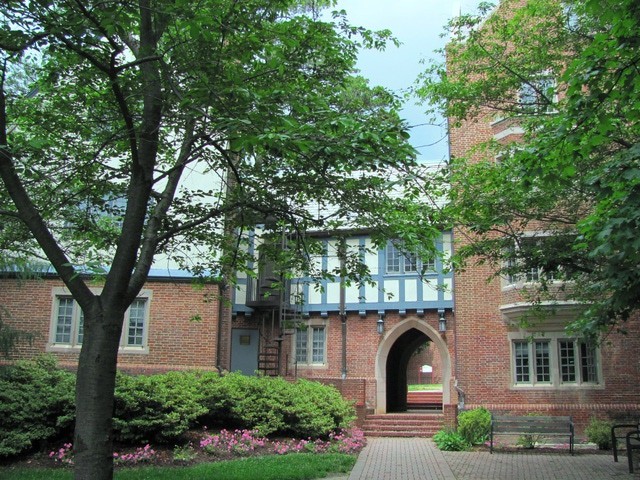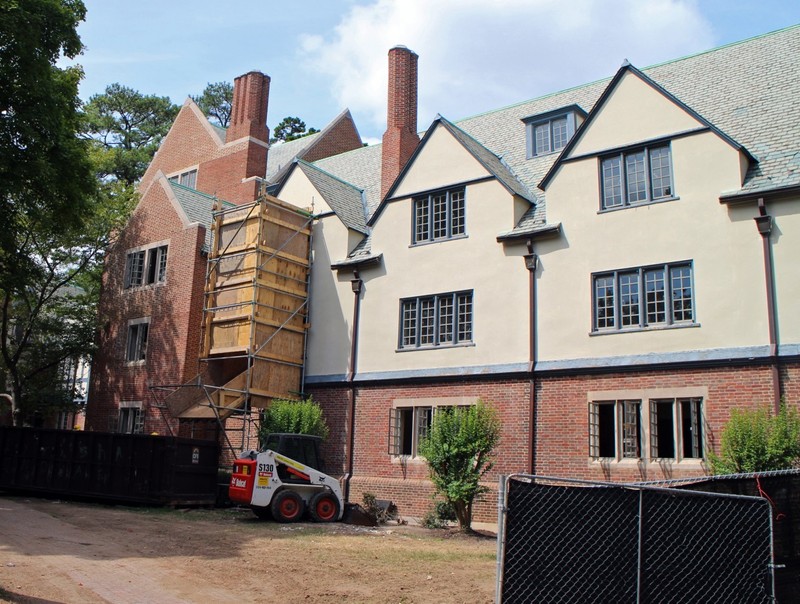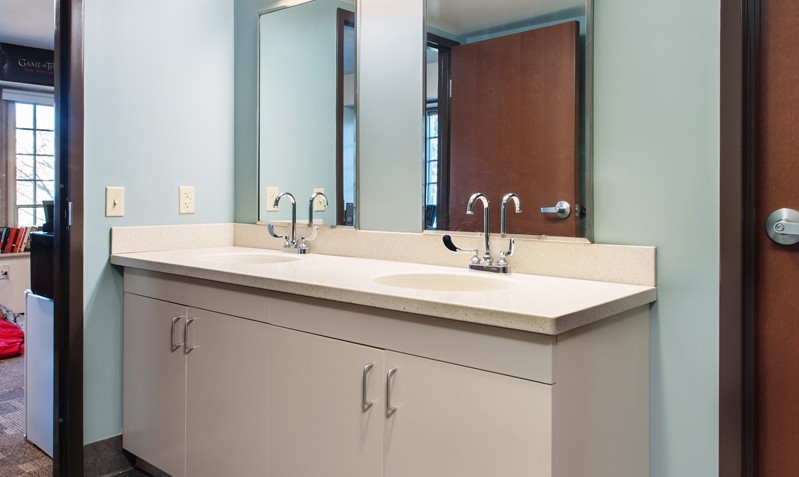Jeter Hall
Introduction
Text-to-speech Audio
Images
Jeter Hall from the front.

Jeter Hall as it underwent renovations to have suite-style dorms in 2014.

One of the suite-style bathrooms in the building's recently renovated dorms.

Backstory and Context
Text-to-speech Audio
Since its construction in 1914, Jeter Hall has survived fires, a bombing, multiple renovations, and over a century of university life. It was one of the original buildings on the University of Richmond’s current campus and was constructed as one of two male residence halls. The building was originally called Dormitory One but became Jeter Hall in 1916. Its namesake, Jeremiah Bell Jeter, was one of the university’s founders and served as a trustee at Richmond College, the university’s college for men. With five sections divided between four floors and a basement, Jeter originally was able to house about 130 students.
For the most part, While Jeter’s primary function has always been to serve as a student residence hall, but it has also has seen many other uses during its lifetime. It housed meeting places for various student organizations throughout the 20th century, and prior to the construction of fraternity lodges in the early 1950s, several of Richmond College’s fraternities gathered in the building. During World War II, Jeter became the home of young men who temporarily stayed at the university as they underwent military training. The residence hall likely saw frequent traffic from the residents of Thomas Hall, the school’s other male dorm, because for several years, the only phones on campus to which male students had access were located in Jeter. The building took on an additional function in 1948, when the infirmary moved into several rooms in the basement after its former location in Milhouser Gymnasium became overcrowded. While students reportedly preferred staying in their own dorms when they were ill, perhaps as a result of the reported moistness of the basement rooms, the infirmary remained in Jeter until it moved to a new residence hall in the late 1950s.
With the construction of additional residence halls, Jeter lost its prominent position as one of only two men’s dorms at the University of Richmond. By the early 1970s, it functioned only partially as a dorm building, as it also housed offices for several academic departments. The building therefore faced a dramatic shift after it underwent major renovations over the summer of 1975 and became solely a dorm building. Jeter underwent another renovation in the early 1990s.
In the first few years of the 21st century, the building became part of efforts to increase interactions between male and female students. While men and women already attended classes together, they had always lived on opposite sides of the lake that divided campus. As a result of increasing concerns over the possibility that this arrangement prevented students from interacting enough with members of the opposite sex, the university administration decided to establish one male dormitory as a female dormitory, and vice versa. Consequently, after nearly a century of housing men, Jeter Hall became a women’s residence hall. Following two additional rounds of renovations, Jeter underwent another transition, as its hall-style bathrooms became suites during the 2014-2015 school year, and it is now home to both males and females.
During the early years of Richmond College, the men of Jeter Hall were highly involved in intramural sports matches. Such involvement was particularly prominent through activities such as the dorm’s participation in intradormitory games, in which the dormitory sections in both Jeter and Thomas Hall competed among themselves in any of a number of different sports. After the determination of the winning team from each building, the victors from Jeter and Thomas would play in a championship match. Jeter Hall residents also engaged in sports tournaments against teams from Thomas Hall and teams of “town men,” students who lived at home and commuted to the university. The Collegian’s heavy reporting of these matches ensured the competitions were highly publicized, and an intense rivalry between the residents of Jeter and Thomas halls developed during the 1920s.
Throughout its existence, Jeter has suffered various instances of moderate damage. The building has survived several fires, which were stifled before they caused any significant destruction. Despite the lack of large impact from the blazes, the building’s inadequate fire safety system created a source of constant concern for decades. Only recently, during renovations several years ago, did Jeter Hall finally gain a sprinkler system. On the opposite end of the spectrum, the building suffered a flood in 1941 as a result of a broken water main that had been part of a fire-safety system. By the time the flooding stopped, water had already spread throughout an entire floor of the building and had begun seeping under dormitory doorways. Jeter Hall’s biggest scare likely came in 1971, after four young men from outside the university placed a homemade bomb in a trash can just outside the building. The bomb exploded, breaking 56 windows and resulting in damages worth $283.10, although there were no injuries were reported.
Other concerns regarding the building have been a simple result of structural inadequacies. For instance, prior to the late 1930s, Jeter Hall’s only bathroom was in the basement, so students frequently had to descend several flights of stairs to reach it. While the building did gain additional restroom facilities, people continued complaining for many years about its poor lighting and lack of cleanliness. By the early 21st century, though, many students considered Jeter Hall one of the better residence facilities on campus, so much so that when dormitory locations were integrated in the early 2000s, women chose Jeter as the men’s dormitory they wanted to occupy.
Cite This Entry
Savannah Wilson and Clio Admin. "Jeter Hall." Clio: Your Guide to History. February 24, 2017. Accessed April 26, 2025. https://theclio.com/tour/180/8/reverse

